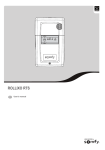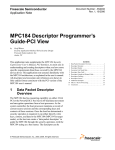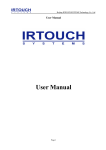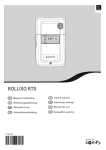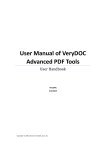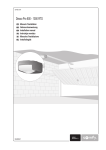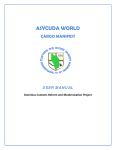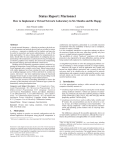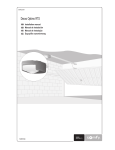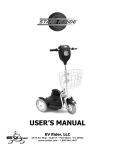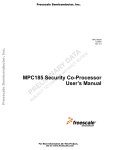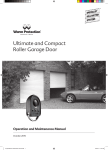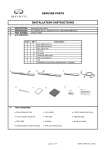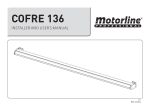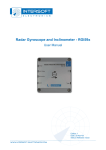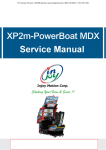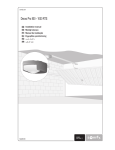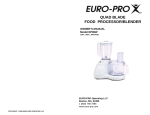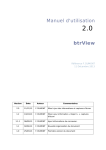Download INSTALLATION AND USER MANUAL
Transcript
INSTALLATION AND USER MANUAL & Important PLEASE READ THESE INSTRUCTIONS CAREFULLY PRIOR TO COMMENCING THE INSTALLATION OF THE DOOR The ALLUGARD door has been designed to provide years of trouble free use. The Door will perform efficiently only if it is installed and operated correctly. READ THESE IMPORTANT SAFETY RULES FIRST This equipment must be installed and used in accordance with these instructions. Failure to follow these instructions could result in damage to the integrity of the safety circuits. Two persons are required to install this product to ensure safe handling procedures. CAUTION Do not wear rings, watches or loose clothing while installing or servicing the unit and ensure correct PPE is worn. To avoid serious personal injury from entanglement, remove any loose objects to the equipment prior to operating door. DANGER Installation and wiring must be in accordance with your local building and electrical regulations. Any electrical work must be carried out by a suitably qualified person, if in doubt consult a qualified electrician. Use only the mains lead supplied with the Remote Control Unit as failure to do so will invalidate the warranty. Connect the mains lead to an adjacent 13amp 3 pin switched socket. The plug must be fitted with a 13 amp fuse. Note: For optimum electrical safety this unit should be connected to circuit protected by a R.C.D. (max 30 mA trip rating). This unit should not be installed in a damp or wet space. DANGER Disconnect electric power to the control unit before making repairs or removing covers. Install the Remote Control Box (or any additional push buttons) in a location where the garage door is visible, but out of the reach of children. Do not allow children to operate push button(s) or remote control(s). Serious personal injury from a closing garage door may result from misuse of the operator. CAUTION: Activate unit only when the door is in full view, free of obstructions and operator is properly adjusted. No one should enter or leave the garage while the door is in motion. Do not allow children to play near the door. NOTE TO INSTALLER PLEASE ENSURE THIS INSTALLATION & USER MANUAL REMAINS WITH THE END USER AS IT CONTAINS IMPORTANT SAFETY AND WARRANTY INFORMATION. 2 COMPONENT CHECK Unpack and check that all components are present. 1. Curtain Assembly (inc. set of Pre-fitted Locking Straps) 2. Axle Assembly (pre-fitted with Motor, Locking Rings and Dummy End) 3. Pair of Guide Rails (pre-fitted with brush strips) 4. Box Assembly Comprising: 1 pair of end plates (pre-fitted with guide rollers & safety break) 1 motor override eye and manual winding handle 1 fittings pack 5. Control System Comprised of:– – Control unit (The light bulb is not covered under manufacturer’s warranty) – Mains lead – Pair magnets – 2No Remote hand transmitters – Safety edge transmitter (The battery is not covered under manufacturer’s warranty) – Fittings Pack 1. PRE-INSTALLATION CHECK IMPORTANT NOTE In case of power failure a manual override system is fitted as standard but this can only be operated from inside the garage. If the garage has no service entrance door then an exterior release kit must be fitted to allow manual operation of the garage door from outside. 1. Check that the door size and colour correspond with that which was ordered. 2. Structural condition of opening Ensure the area around the opening is strong enough to support the door The surface where the door is to be fitted must be flush and reasonably smooth. Small irregularities in the brickwork will be acceptable. The lintel must not protrude backwards or forwards from the brick piers. Should the lintel protrude backwards or forwards from the brick piers this will require special instructions, please consult your AlluGuard Approved Installer. 3. Fitting Notes 3.1. It is recommended that 2 people are available for fitting all door sizes. 3.2. The door must be fitted square and level, irrespective of the shape of the opening;; on no account should any compensation be made to suit an irregular opening. 3.3. Ensure all necessary tools are to hand before starting. 3.4. The door package and its contents should be checked for obvious damage before removal of the wrapping. IF THERE IS ANY DAMAGE YOUR SUPPLIER SHOULD BE CONTACTED IMMEDIATELY. 4. Ensure there is a suitable 13amp 3 pin switched socket adjacent to where the Remote Control Box is to be fitted. 5. Ensure all tools and door components are gathered together inside the garage prior to starting the installation. Tools required:– 2 Stepladders 3.8 drill bit Spirit level 7.0 drill bit Steel tape 11.0 drill bit Power drill Hacksaw 10mm A/F spanner Suitable wall plugs (not supplied) Slot screwdriver Small electrical screwdriver Pozidrive screwdriver 3mm A/F Allen key 4mm A/F Allen key Suitable fixings (not supplied) 2. CHECK HEADROOM 3 The headroom is the clear vertical height required between the top of the guide rails and any obstruction above the shutter as shown in (Fig1 & Fig2). This space is required to house the door roll headroom of 205mm / 300mm is required. (AG55 requires 205mm & AG77 requires 300mm) Limited Head room If insufficient headroom is available the door can still be fitted (see your survey sheet) but the shorter guide rails will give a corresponding reduction in door opening height as shown in (Fig3). The curtain will require 1 lath to be removed for every 75mm of reduction in the guide height. Note: Ensure that the headroom above the guides is clear of any obstructions (especially small protrusions or nail heads) which could cause damage to the door roll during installation/operation. Fig 1 Headroom within aperture Fig 2 Headroom behind aperture Fig 3 Limited headroom 3. 3.1 3.1.1 PREPARING THE GUIDE RAILS For Fitting Within The Aperture Check Guide Rail Length Check that guide rails have been supplied to the correct length as per your survey sheet / order. The correct length is aperture height less 205mm or 300mm as shown in (Fig1). 3.1.2 Drill Fixing Holes Drill holes through 7mm diameter and counter drill 11mm diameter as shown in (Fig4). A minimum three holes per rail are required, positioned as shown in (Fig5). NB. Position holes for best fixing to brickwork. 3.2 3.2.1 For Fitting Behind The Aperture Check Guide Rail Length Check that guide rails have been supplied to the correct length as per your survey sheet/order. a. Where headroom of 205mm / 300mm or more is available guide rail length equals aperture height as shown in (Fig6). b. Where only limited headroom is available guide rail length equals total available height less 205mm / 300mm as shown in (Fig7). Fig 4 3.2.2 Fig 5 Fig 6 Drill Fixing Holes Drill holes through 7mm diameter & counter drill 11mm diameter as shown as shown in (Fig8) A minimum three holes per rail are required as shown as shown in (Fig9) 4 NB position holes for best fixing to brickwork. Fig 7 Fig 8 Fig 9 4. 4.1 ASSEMBLY FRAMEMBLE FRAME L/H or R/H Motor (Factory Fitted as Standard) The motor and control unit can be mounted on either the L/H side or R/H side. (Please specify at time of order) All AlluGuard doors are fitted with a safety brake as standard excluding AG55 Doors shown in (Fig10). • If you want to change the hand of the motor this should be carried out by a suitably trained engineer • If you do move the Motor & Safety Brake ensure that these are installed correctly otherwise the unit will not activate under normal running conditions. • It is important that the head plates are securely fixed to the wall. 4.2 End Plates and Safety Brake Device* (Safety brake factory fitted as Standard) Lay the Head assembly on the ground, parallel with and just inside the garage opening. Ensure the motor is situated at the correct end for your installation and that the motor limit adjusters are at the top/bottom as shown in (Fig11). Fix the motor plate to the end plate by using four M6 x 25 countersunk screws and Nyloc nuts provided. Fig 10 Fig 11 The bridle is semi fitted to the safe brake, to attach correctly you must remove the loose bolts to the bridle. Slide the dummy end shaft into the safe brake hole. Re-fit the bridle to the un-fixed diagonal holes using the loose bolts provided make sure the bridle is placed within the dummy end shaft groove. Tighten the loose nuts & bolts fully. 5 4.3 Fit Guide Rails Select R/H guide rail and slide fully onto the bottom square tube spigot projecting from the R/H end plate, please ensure that the End Plate is flush with the face side of the guide rail. Repeat for the L/H guide rail as shown in (Fig 12). Fig 12 5. INSTALL FRAME You will have drilled your guide rails, as shown in (Fig4 or Fig8) for fitting either:- a) Within the aperture b) Behind the aperture Please proceed accordingly. (SAFETY NOTE: 2 people required) 5.1 Fitting Within Aperture For installation within the aperture we strongly recommend the use of a cover box as this covers and protects the door curtain roll. 5.2 If either half box or full box options are specified these will be supplied factory fitted to the end plates. 5.3 Fig 13 Lift the frame assembly into position and align with the front of the aperture. Ensure the guide rails are VERTICAL (in both directions) and parallel to each other, at the same height and the correct distance apart. NB: Some width adjustment is available on the sliding shaft end of the axle. The correct distance is shown in (Fig13). – AG77 Door Ensure the axle assembly is horizontal by using a spirit level. 5.1.3 Once the frame is correctly positioned, mark and drill for fixings (fixings not supplied). 5.1.4 When the guide rails are securely fixed, double check that they are vertical, parallel and correct distance apart and that the axle assembly is level. 5.4 Fixing The Head Plates Fix the head-plates into position ensuring that the head-plates are level and that the locating pegs are fully located into the guide section. Fix securing screws through back of head-plate and attach securely to the wall. Where a back box is fitted it may be necessary to fix the back box to the opening header to stop any marking of the curtain during door operation. If additional fixings are required in the back box, use countersunk screws, ensuring that the screw heads do not protrude, as curtain damage could occur. Always ensure that the back box is adequately fixed to eliminate any rubbing of the curtain on the back box during the door operation. 5.5 Fitting Behind Aperture Lift the frame assembly into position and align centrally with the aperture. Ensure the guide rails are vertical (in both directions) and are parallel to each other, at the same height and the correct distance apart. NOTE: Some width adjustment is available on the sliding shaft end of the axle. The correct distance apart is shown in (Fig13). Ensure axle assembly is horizontal by using a spirit level. 5.6 Once the frame is correctly positioned, mark and drill for fixings (fixings not supplied). 5.7 When guide rails are securely fixed, double check for vertical, parallel and correct spacing and that the axle is level. 6 NOTE: Once the frame is fully fitted and checked, use the plastic plugs supplied to cover the fixing holes in the guide rails to give a ‘fully finished’ effect. 5.8 Fixing the Head Plates Fix the head-plates into position ensuring that the head-plates are level and that the locating pegs are fully located into the guide section. Fix securing screws through back of head-plate and attach securely to the wall. Where a back box is fitted it may be necessary to fix the back box to the opening header to stop any marking of the curtain during door operation. If additional fixings are required in the back box, use countersunk screws, ensuring that the screw heads do not protrude, as curtain damage could occur. Always ensure that the back box is adequately fixed to eliminate any rubbing of the curtain on the back box during the door operation. 6. INSTALLING THE CURTAIN ASSEMBLY 6.1 Carefully unwrap and remove the outer bubble wrap protection and place over shaft to stop damage to inside of curtain during installation. 6.2 Carefully position the curtain assembly in the door aperture, below the axle as shown in (Fig14), slit the packaging to gain access to the curtain but leave some packaging to protect the curtain. Fig 14 6.3 SAFETY NOTE: A minimum two people are required for this procedure to ensure safe handling. 6.4 It is essential to place sections of bubble wrap over the axle to prevent marking the curtain as it is installed. 6.5 Using minimum 2 people carefully lift the curtain assembly up level with the axle. Practice has shown that it is best to place one hand on the axle, keeping that arm straight, and support the curtain roll on that shoulder as shown in (Fig 15). 6.6 Feed the bottom lath over the top of the axle and down between the guide rails, as shown in (Fig16) taking care not to scuff the curtain assembly, proceed until half of the curtain has been fed over the axle, carefully un-roll the remaining curtain until this is balanced over the shaft, once this is done carefully feed the curtain into the guide until the curtain is reaches the floor. NOTE: Do not let the curtain ‘free fall’ over the axle as this will result in damage to the Curtain and/or the Safety Edge Transmitter Fig 15 Fig 16 7 7. 7.1 ATTACH THE CURTAIN Fit the Motor Override Attach the ‘Motor Override Eye’ fitting to the motor as shown in (Fig17) using 3mm screw. 7.2 Position the Axle Use the motor override to rotate the axle shaft. Rotate the axle until the locking joint attachment holes are positioned as shown in (Fig18). 7.3 Locking Ring There is a locking ring positioned on the shaft for each locking strap;; the number of locking rings will vary according to curtain width and AG55 - 2 rings & AG77- 1 ring per strap. Position the outermost ring/s to the shaft approx. 150mm in from each end and equally space the other/s as shown in (Fig19). Slide each locking strap along the top lath and engage the fastening pin into the appropriate hole in the respective clamped locking ring/s, (AG55 Doors). Fig 17 Slide the loose locking ring to engage the other end of the fastening pin and secure the loose locking ring to the shaft using the self tapping screw on AG55 doors. Repeat this for each locking strap, as shown in (Fig19). 7.4 Locking Ring (AG77) The locking rings are pre attached on the barrel, to connect the locking straps line up with the locking ring hole and insert pin. Fig 18 Fig 19 8 8. CONNECT THE ELECTRICS 8.1 Preparing the AlluGuard Roller Garage Doors for Remote Control for Installation • Remove the integrated light cover from the top of the Somfy Rollixo Control Unit • Unscrew and remove the receiver cover from the unit by loosening the one screw at the base of the unit. 8.2 Fixing the Somfy Rollixo Remote Control to the Wall • Make sure that the unit is mounted onto internal brickwork and is firmly fixed. • The unit must be installed with the courtesy light at the top. Hold the unit against the wall at a height of at least 1.6 meters and mark where the screw fixings should be as shown in (Fig20) • Take the unit away and drill the holes. Fix unit to the wall. THIS MUST BE FITTED INSIDE THE GARAGE AS IT IS NOT IP RATED 8.3 Plug power lead into 13A socket but DO NOT SWITCH ON at this stage. 9. SETTING CURTAIN OPEN AND CLOSE POSITION SOMFY MOTOR SET-‐UP Motor and Fall Protection Wiring The receiver must not be connected to the mains power supply during connection to the motor. 9.1 9.1.1 Fig 20 Motor Wiring Connect the motor to the receiver. Note: the motor's direction of rotation shall then be checked and reversed if necessary. 9.1.2 Lock the motor cable with the cable clamp provided. The motor cable must be placed in the receiver's 230v insulation area. Fall protection wiring If no fall protection is connected, it is essential to create the bridge between terminals 5 and 6 of the receiver (with the shunt provided). 9.2 Connecting the Receiver to the Mains Power Supply 9.2.1 Fully unfold the receiver aerial so that it is pointing downwards 9.2.2 Screw the bulb supplied into the receiver. (Before connecting to mains power supply) 9.2.3 Replace and screw in the receiver cover. 9.2.4 Refit the integrated light cover. 9.2.5 Connect the receiver to the mains power supply. All the indicator lights come on and then go out. If indicator light 1 comes on permanently, fall protection is not connected or incorrectly connected to the receiver. If indicator light 2 comes on permanently, the safety edge has not been detected by the receiver (radio safety edge transmitter not yet memorised or the wired safety edge is still not connected). 9.3 9.3.1 Checking the Direction of Rotation of the Motor and Adjustment of the Motor End Limits Press simultaneously on the ˄ and ˅ buttons until the motors up and down movement occurs to enter motor adjustment mode. • 9.3.2 Press button ˄ or ˅ to check the motor's direction of rotation. • • 9.3.3 Indicator light 1 flash’s slowly. If the motor's direction of rotation is correct, move on to step [3] of the motor end limit setting procedure. If the direction of rotation is incorrect, press button (stop) until the motors up and down movement occurs, check the motor's direction of rotation again and move on to step [3] of the motor end limit setting procedure. If the motor end limits are already set, move on to step [8] to exit motor adjustment mode. • If the motor end limits are not set, check that the motor is released: the two push-buttons should be pressed. Note: The motor end limits can also be set with a setting tool (ref. 9015971). In this case, set the motor end limits with the cable then move on to step [8] to exit motor adjustment mode. 9 9.3.4 Press ˄ button to position the garage door in the upper position. • Adjust the upper position with buttons ˄ and ˅. 9.3.5 Press the motor's upper end limit push-button. 9.3.6 Press ˅ button to position the garage door in the lower position. 9.3.7 Press the motor's low end limit push-button. 9.3.8 Press simultaneously on the ˄ and ˅ buttons or press the (prog) button until the motor's up and down movement occurs to enter motor adjustment mode. • • Adjust the low position with buttons ˄ and ˅. Indicator light 1 goes out. ELLARD MOTOR LIMIT SET-‐UP 9.4 Limit Switch Adjustment (see Fig 22) The limits are set at the factory to 8 revolutions of the shaft, A 4mm ‘Allen Key’ limit adjuster is used to adjust them further. Allow the motor to run downwards without the curtain attached to enable the shaft to determine bottom limit position, without curtain attached to shaft. 9.5 Adjustment ‘Up’ Run the motor up with the curtain attached, if the motor stops short of fully open, turn the adjusting screw in the + direction (this is the adjuster indicated by the rotation of the barrel. This will allow the motor to run on in the up direction. Stop the motor before it gets to the fully open position and wind the adjuster in the – direction until it stops before the fully open position. Keep the open button pressed and at the same time slowly turn the adjuster in the + direction until the door stops at the fully open position. If the motor runs too high, turn the adjustment screw towards the - direction until the motor stops in the correct position. 10 Fig 21 9.6 Adjustment ‘Down’ Run the motor down, if the motor stops short of the closed position, turn the adjustment screw towards the + direction keeping the control pressed in the down direction until the correct position is reached. If the motor runs too far turn the adjustment screw towards the – direction. Set open position as shown in (Fig 21). 9.7 Checking the Limit Positions Run the motor in both directions until the limit switches cut out the motor travel. Carry out any fine adjustments. One turn of the adjustment screw corresponds to approximately 70° turn of the roller tube. In order that the locking joints operate effectively, the position of the shaft in the closed position needs to be finely adjusted. Fig 22 Do not adjust past this position as this will impose excessive loads on the mechanism. This motor is fitted with a thermal trip;; this stops the motor from overheating. Be aware that excessive running of the door may cause the thermal trip to operate, if this happens;; please wait 20 minutes before trying to operate the door again. 10. POSITION THE MAGNETS ON THE DOOR GUIDE & PROGRAMMING THE SAFETY EDGE TRANSMITTER Start with the roller door at its top limit, if positioning the top magnet (AG55 Doors with 12RPM Motor) you should measure down 50mm from the bottom of the safety edge transmitter and turn on dipswitch 4 within the safety edge transmitter. The top magnet housing should be placed flush with the edge of the guide, as shown in (Fig 22). Fix the top magnet to the guide using the adhesive pad provided until the roller door is commissioned and then fix using the self tapping screws provided. To position the bottom magnet, close the roller door. Mount the magnet flush with the edge of the guide so that the top of the magnet is level with the top of the safety edge transmitter, as shown in (Fig 23);; fix the bottom magnet to the guide using the adhesive pad provided until door is commissioned, then fix using the self tapping screws provided. 11 Fig 22 Fig 23 Programming the XSE transmitter in to the Rollixo receiver Press the ‘Prog’ button on the Rollixo RTS front panel until the LED above the Prog button lights up RED. Press the ‘PROG’ button on the safety edge transmitter for approximately 4 seconds until the ‘Prog’ LED on the Rollixo RTS controller flashes and then goes out. Fig 22 The safety edge transmitter is now paired, check the operation of the door & check the safety edge activates when compressed. Please refer to the Somfy instructions on commissioning a safe edge if required. Additional Problem Solving 10.1 Door Tight Or Jams In Operation - - - - Check for good entry of curtain laths into guide rails. Check that bottom lath is correctly engaged into track when fully open, as shown in (Fig16). Check for correct clearance of curtain in guide rails. NB: laths should have a sideways ‘end float’ of approx 6mm. Adjust guide rails if necessary to achieve free movement. Poor Range on Transmitters • Is the aerial positioned? • Check batteries in hand set, small LED on hand set will appear dull if battery of poor quality. • Interference from illegal transmissions on 433 frequencies. 11. OPERATING INSTRUCTIONS 11.1 General Operation Your Alluguard door can be operated from outside or inside the garage using the Remote Control Handset, or from inside the garage using the Control Panel on the Rollixo Control Box. 12 CAUTION: Activate unit only when the door is in full view, free of obstructions and operator is properly adjusted. No one should enter or leave the garage while the door is in motion. Do not allow children to play near the door. 11.2 In Event Of Power Failure If the door is not used during the power failure then no action has to be taken as the unit will reset itself when the power is restored. If required the door can be operated manually by using the winding handle supplied, for which you have to gain access to the inside of the garage. Insert the hooked end of the winding handle into the override eye;; this is projecting downwards from the drive motor at one end of the curtain roll, as shown in (Fig17). Rotate the handle to operate the door to open or close. IMPORTANT If the garage has no service door then an EXTERIOR RELEASE KIT should have been fitted to allow EMERGENCY opening from outside. Follow instructions supplied with that kit. Note: When closing the door manually ensure that the locking joints are set in the fully closed position to ensure security. Insert the hooked end of the winding handle into the override eye;; this is projecting downwards from the drive motor at one end of the curtain roll as shown in (Fig17), rotate the handle to operate the door to open or close. 11.3 Maintenance The Alluguard door is essentially a low maintenance product but certain simple checks, carried out regularly, will ensure extended trouble free operation. CLEANING - Periodically wash the door curtain with warm soapy water using a soft cloth. - Check and clean out the guide rails, removing any accumulated leaves and debris. - Ensure door closes onto a level clean surface. SAFETY - Regularly check the safety reverse system for correct operation. 11.4 Accessories The following accessories are available for use with your ALLUGUARD door:- Hand Transmitter 1000 VA battery back up Wireless Key Pad 650 VA battery back up Up/down switch Touch up paint ALL COLOURS Exterior release kit Vision Lath Wired key switch Vented Lath Photo Electric Cells Half Box or Full boxes are available in all matching painted colours cut to your required length. A battery backup system is available to suit all sizes of AlluGuard doors, details on request. 11.5 How To Avoid Costly Service Charges Problem / Action Door does not operate 1. Check electrical supply to unit 2. Press hand set button again 3. Check light flashing sequence 4. Check fuse on plug and replace is necessary Drive motor operates but door does not move 5. Ensure rigid links are still attached to the door Door auto-reverses after closing fully 6. Check for obstructions Door runs erratically 7. Check control box light sequence 8. Ensure safety edge is intact and magnets are positioned correctly or have not fallen off Door open and closed positions are incorrect 9. Call a qualified installer - DO NOT TRY TO CORRECT THIS PROBLEM YOURSELF, IT COULD LEAD TO HARM Hand set range diminishes 13 10. Replace handset battery 11. Check position of Ariel on unit to ensure it is straight;; you may experience interference with other networks in the area, i.e. pylons 12. Operate the handset within sight of the door Door stops during opening 13. Check door is not jammed in tracks 14. Ensure safety edge is intact and magnets are positioned correctly or fallen off 14 EMR (Exterior Release Kit) Installation Instructions 15 Rollixo RTS XSE Kit Contents The Rollixo XSE Kit is supplied with the following: No. Description 1 1 x Rollixo RTS Controller 2 1 x Rollixo RTS Installation Guide 3 1 x Rollixo RTS End User Guide 4 1 x Quick Fit Mains Supply Cable 5 1 x Wiring Accessory Bag – Contains: 1 x Motor Supply Cable Clamp & 2 x Cable Clamp Screws 1 x Wire Link (to bridge the safety brake terminals) 1 x Alarm Sounder Screw 6 2 x Keygo 4 RTS Radio Keyfobs 7 1 x Courtesy Light Bulb 8 1 x XSE Safety Edge Transmitter 9 1 x XSE Safety Edge Transmitter Installation Guide 10 1 x Bag of XSE Safety Edge Transmitter Screws (x4) 11 1 x Guide Magnets (2 x Magnets with AG55 12RPM Motors) 16 System Diagnostics The Rollixo Remote Control System provides a full fault finding diagnostic programme, this is all dependant on there being power to the unit. AlluGuard Roller Garage Doors AlluGuard Doors Ltd, Rotherham Road, Parkgate, Rotherham, S62 6FP 17

















